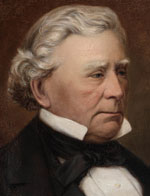Crossing the Blue Mountains
Attempts to cross the mountains lying to the west of Sydney had been made from 1790, by convicts seeking a way of escape and adventurers keen to explore the region. Most tried to follow the rivers upstream only to be stopped by rapids or sheer cliffs. Others became lost in deep gorges or were forced to turn back by the thick scrub.
Francis Barrallier (1773-1853), aide de camp to Governor King, led two expeditions into the foothills of the Blue Mountains in 1802. He discovered Burragorang Valley but was prevented from travelling further by a large waterfall. Read more about Francis Barrallier in our online story, The French in Australia.
George Caley (1770-1829), botanist and plant collector to Sir Joseph Banks, went on regular collecting excursions into the Blue Mountains to gather natural history specimens. A monument at Linden is named for Caley but he is not known to have reached this far west.
Left: Gregory Blaxland Esq, by an unknown artist, Pencil drawing ML 143
Centre: William Lawson, c.1840, Miniature portrait MIN 63
Right: William Charles Wentworth, 1872, by James Anderson, Oil painting on canvas ML 411
Finding a way to the west
In May 1813, Gregory Blaxland (35), William Lawson (39) and William Charles Wentworth (21) set out with a plan to find a passage to the western plains by following a line of ridges that ran westward between two river valleys.
Gregory Blaxland (1778-1853) had arrived in NSW in 1805 and acquired land near Eastwood. Keen to find new pastureland for his sheep, Blaxland undertook several excursions to find the best method of crossing the mountains, before petitioning Governor Macquarie for permission to form an exploration party.
William Lawson (1774-1850) had trained as a surveyor in England before joining the NSW Corps. He arrived in Sydney in 1799. By 1813, Lawson was an experienced colonial officer with lands at Prospect, NSW, when he accepted Blaxland's invitation to join the expedition.
William Charles Wentworth (1790-1872), son of D'Arcy Wentworth, was a currency lad (locally-born European). Educated in England, he returned to the colony. In 1811, he was appointed Acting Provost Marshall by Governor Macquarie and granted 1750 acres on the Nepean River. A future barrister, author, and statesmen, Wentworth's youth and adventurous spirit made him an obvious choice for the expedition.
All three explorers kept journals, each in their own style - Blaxland published his account in 1823 and Wentworth wrote enthusiastically about the landscape, resources and future benefits to the colony but, for those seeking to retrace the explorers' trail, Lawson's journal could be regarded as the most important.
> Read the journal of William Lawson
> Read the journal of William Charles Wentworth
The expedition also included a local guide, three convict servants, four pack horses and five dogs. They left Blaxland's South Creek farm (near St Marys) at 4pm on Tuesday 11 May, 1813, heading for their first night's camp in the foothills of the mountains.
The exploring party quickly fell into the daily routine which could explain their success where others had failed. Waiting until the dew had dried off the bush each morning they left two servants with the horses and supplies in camp. The men then navigated their way through the thick scrub for about 4 - 5 miles, marking the trees on either side of the trail, before turning back and cutting a path for the horses to follow the next day.
It was tedious, time consuming work - requiring the explorers to go over the same ground three times in order to make progress. After taking 21 days to find a way through 50 miles of the most rugged terrain in the Blue Mountains, the party reached the heights of Mount Blaxland. From there they saw a vast expanse of forest and grass land stretching before them, rich enough to 'support the stock of the colony for the next thirty years.' (Blaxland, 1823)
Detail from The Blue Mountains Pioneers, Sydney Mail, Christmas Supplement, 1880
Engraving. DL X8/1-3
With supplies running low, their clothes and shoes in tatters and several of the men now ill, they ended their expedition and headed for home. In stark contrast, the return journey was a simple matter, achieved in a third of the time, as they had only to follow their own clearly blazed trail.
News of the explorers' success was greeted with much fanfare in Sydney. Though the party had stopped short of crossing over the mountains, a trail had been blazed. With the way to the west now open, plans were soon afoot to complete the crossing.
> Explore maps, pictures and journal extracts from Macquarie's crossing of the Blue Mountains









